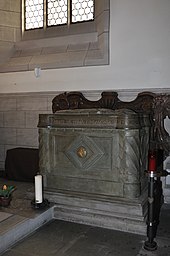Radolt of Verona

Radolt von Verona , also Ratold or Radolf (Radulph) , it. Ratoldo or Rotaldo (* around 770; † September 13 between 840 and 858 in Radolfzell ), was bishop of Verona from 799/802 to 840 and is a saint of the Catholic Church.
Origin and education
Radolt was a resident and received his training in the then top-class monastery school in Reichenau . After the conquest of the Longobard Empire by Charlemagne in 774, Egino , also an Aleman with a Reichenau background, was installed as the new, loyal bishop of Verona in 780, and Radolt became a member of his cathedral clergy. In 799 Egino withdrew to Reichenau and founded the Cella St. Peter and Paul there , where he died in 802.
Bishop of Verona
Radolt was Egino's successor on the Veronese bishop's chair, as well as the court orchestra leader of the son of Charles Pippin of Italy . In 801 he checked along with this the Count Scrot of Florence to the monastery rails made relics translation of St. Genesius . Also with Pippin, he initiated the restoration of the San Zeno monastery in Verona in 807 . With the Pagina firmitatis of June 24, 813, he divided the income of the Bovolone estate, which had previously been granted exclusively to the bishop, in equal parts between the bishop, cathedral clergy, cathedral builder and poor welfare. Politically, he was on the side of Louis the Pious in the power struggles of the time after 815 and reported the uprising of Bernhard of Italy to him . In 834 he played a key role in the liberation of Ludwig's wife Judith from Tortona and her return to Aachen . In doing so, however, he had made enemies in Italy and could no longer return to his bishopric.
Founder of Radolfzell
Radolt had already created a place of retreat in his Reichenau home based on the example of Eginos. In 826 he founded the Cella, which later became the Abbey and City of Radolfzell. According to tradition, his wish to take over Eginos Cella at the tip of the island had been rejected by the abbot and instead he had been assigned the area on the opposite bank, which also belonged to the abbey. Radolt endowed the new foundation with relics of St. Theopontus and Senesius (from Treviso ) and St. Zeno (from Verona). In 830 he gave the Reichenau Abbey relics of the Evangelist Mark , which he had acquired in Venice . The dramatic translation legend De miraculis et virtutibus beati Marci evangelistae , from which most of the information about Radolt's life comes, reports on this. Allegedly Radolt had to promise in Venice to keep the true identity of the relics secret, so that their veneration in the Münster Mittelzell only began in the 10th century.
From 834 Radolt lived mainly in Radolfzell. In 840 he formally renounced the Cathedra of Verona. The day of his death, September 13th, has been necrologically recorded , but not the year for which only general data can be obtained.
Adoration
Radolt's grave is in the Minster of Our Lady in Radolfzell. He was canonized in 1300 . Liturgical feast day is September 13th. The pastoral care unit of the Catholic parishes in Radolfzell is under his patronage .
literature
- Thomas Zotz: Ratold. In: New German Biography (NDB). Volume 21, Duncker & Humblot, Berlin 2003, ISBN 3-428-11202-4 , p. 183 f. ( Digitized version ).
Individual evidence
- ↑ Thomas Zotz: Ratold. In: New German Biography (NDB). Volume 21, Duncker & Humblot, Berlin 2003, ISBN 3-428-11202-4 , p. 183 f. ( Digitized version ).
Web links
| personal data | |
|---|---|
| SURNAME | Radolt of Verona |
| ALTERNATIVE NAMES | Ratold; Radolf; Ratoldo (Italian); Rotaldo (Italian) |
| BRIEF DESCRIPTION | Bishop of Verona and saint of the Catholic Church |
| DATE OF BIRTH | around 770 |
| DATE OF DEATH | September 13 between 840 and 858 |
| Place of death | Radolfzell on Lake Constance |